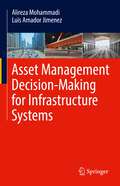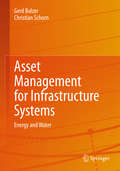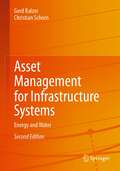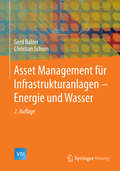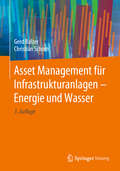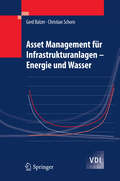- Table View
- List View
Asset Backed Securities-Transaktionen und Kreditderivate nach IFRS und HGB (Forschungsreihe Rechnungslegung und Steuern)
by Ralf StruffertAufbauend auf einer agency-theoretischen Analyse stellt Ralf Struffert die derzeit nach IFRS und HGB bzw. den Verlautbarungen des IDW geltenden Bilanzierungsregeln ausführlich vor. Die Ergebnisse einer Expertenbefragung bieten Anhaltspunkte für die Lösung konkreter Bilanzierungsprobleme und sind bei der Klärung eventueller Konflikte zwischen Bilanzierendem und Wirtschaftsprüfer über die Anwendung der Bilanzierungsregeln auf ABS-Transaktionen und Kreditderivatgeschäfte hilfreich.
Asset Condition, Information Systems and Decision Models (Engineering Asset Management Review)
by Joe E. Amadi-Echendu, Roger Willett, Kerry Brown and Joseph MathewAsset Condition, Information Systems and Decision Models, is the second volume of the Engineering Asset Management Review Series. The manuscripts provide examples of implementations of asset information systems as well as some practical applications of condition data for diagnostics and prognostics. The increasing trend is towards prognostics rather than diagnostics, hence the need for assessment and decision models that promote the conversion of condition data into prognostic information to improve life-cycle planning for engineered assets. The research papers included here serve to support the on-going development of Condition Monitoring standards. This volume comprises selected papers from the 1st, 2nd, and 3rd World Congresses on Engineering Asset Management, which were convened under the auspices of ISEAM in collaboration with a number of organisations, including CIEAM Australia, Asset Management Council Australia, BINDT UK, and Chinese Academy of Sciences, Beijing University of Chemical Technology, China. Asset Condition, Information Systems and Decision Models will be of particular interest to finance, maintenance, and operations personnel whose roles directly affect the capability value of engineering asset base, as well as asset managers in both industry and government.
The Asset Economy
by Lisa Adkins Melinda Cooper Martijn KoningsRising inequality is the defining feature of our age. With the lion’s share of wealth growth going to the top, for a growing percentage of society a middle-class existence is out of reach. What exactly are the economic shifts that have driven the social transformations taking place in Anglo-capitalist societies? In this timely book, Lisa Adkins, Melinda Cooper and Martijn Konings argue that the rise of the asset economy has produced a new logic of inequality. Several decades of property inflation have seen asset ownership overshadow employment as a determinant of class position. Exploring the impact of generational dynamics in this new class landscape, the book advances an original perspective on a range of phenomena that are widely debated but poorly understood – including the growth of wealth inequalities and precarity, the dynamics of urban property inflation, changes in fiscal and monetary policy and the predicament of the “millennial” generation. Despite widespread awareness of the harmful effects of Quantitative Easing and similar asset-supporting measures, we appear to have entered an era of policy “lock-in” that is responsible for a growing disconnect between popular expectations and institutional priorities. The resulting polarization underlies many of the volatile dynamics and rapidly shifting alliances that dominate today’s headlines.
The Asset Economy
by Lisa Adkins Melinda Cooper Martijn KoningsRising inequality is the defining feature of our age. With the lion’s share of wealth growth going to the top, for a growing percentage of society a middle-class existence is out of reach. What exactly are the economic shifts that have driven the social transformations taking place in Anglo-capitalist societies? In this timely book, Lisa Adkins, Melinda Cooper and Martijn Konings argue that the rise of the asset economy has produced a new logic of inequality. Several decades of property inflation have seen asset ownership overshadow employment as a determinant of class position. Exploring the impact of generational dynamics in this new class landscape, the book advances an original perspective on a range of phenomena that are widely debated but poorly understood – including the growth of wealth inequalities and precarity, the dynamics of urban property inflation, changes in fiscal and monetary policy and the predicament of the “millennial” generation. Despite widespread awareness of the harmful effects of Quantitative Easing and similar asset-supporting measures, we appear to have entered an era of policy “lock-in” that is responsible for a growing disconnect between popular expectations and institutional priorities. The resulting polarization underlies many of the volatile dynamics and rapidly shifting alliances that dominate today’s headlines.
Asset Intelligence through Integration and Interoperability and Contemporary Vibration Engineering Technologies: Proceedings of the 12th World Congress on Engineering Asset Management and the 13th International Conference on Vibration Engineering and Technology of Machinery (Lecture Notes in Mechanical Engineering)
by Joseph Mathew C. W. Lim Lin Ma Don Sands Michael E. Cholette Pietro BorghesaniThese proceedings include a collection of papers on a range of topics presented at the 12th World Congress on Engineering Asset Management (WCEAM) in Brisbane, 2 – 4 August 2017. Effective strategies are required for managing complex engineering assets such as built environments, infrastructure, plants, equipment, hardware systems and components. Following the release of the ISO 5500x set of standards in 2014, the 12th WCEAM addressed important issues covering all aspects of engineering asset management across various sectors including health. The topics discussed by the congress delegates are grouped into a number of tracks, including strategies for investment and divestment of assets, operations and maintenance of assets, assessment of assets’ health conditions, risk and vulnerability, technologies, and systems for management of assets, standards, education, training and certification.
Asset-Liability and Liquidity Management
by Pooya FarahvashAsset-Liability and Liquidity Management distils the author’s extensive experience in the financial industry, and ALM in particular, into concise and comprehensive lessons. Each of the topics are covered with a focus on real-world applications, based on the author’s own experience in the industry. The author is the Vice President of Treasury Modeling and Analytics at American Express. He is also an adjunct Professor at New York University, teaching a variety of analytical courses. Learn from the best as Dr. Farahvash takes you through basic and advanced topics, including: The fundamentals of analytical finance Detailed explanations of financial valuation models for a variety of products The principle of economic value of equity and value-at-risk The principle of net interest income and earnings-at-risk Liquidity risk Funds transfer pricing A detailed Appendix at the end of the book helps novice users with basic probability and statistics concepts used in financial analytics.
Asset-Liability and Liquidity Management
by Pooya FarahvashAsset-Liability and Liquidity Management distils the author’s extensive experience in the financial industry, and ALM in particular, into concise and comprehensive lessons. Each of the topics are covered with a focus on real-world applications, based on the author’s own experience in the industry. The author is the Vice President of Treasury Modeling and Analytics at American Express. He is also an adjunct Professor at New York University, teaching a variety of analytical courses. Learn from the best as Dr. Farahvash takes you through basic and advanced topics, including: The fundamentals of analytical finance Detailed explanations of financial valuation models for a variety of products The principle of economic value of equity and value-at-risk The principle of net interest income and earnings-at-risk Liquidity risk Funds transfer pricing A detailed Appendix at the end of the book helps novice users with basic probability and statistics concepts used in financial analytics.
Asset Liability Management (ALM) in Banken
by Martin Spillmann Karsten Döhnert Roger RissiDieses Buch vermittelt Bankpraktikern in den Bereichen Treasury, Risikomanagement, Controlling, Reporting und Regulierung den neuesten Stand im Bilanzstrukturmanagement. Die Autoren zeigen aktuelle Entwicklung auf und weisen auf mögliche Optimierungspotenziale hin. Im Zentrum stehen das Management von Zinsrisiken im Bankbuch, von Refinanzierungs- und Fremdwährungsrisiken. Neben der erwähnten Zielgruppe profitieren von der Lektüre auch Verantwortungs- und Entscheidungsträger mit operativer Verantwortung (CRO, CFO), Verwaltungsräte (vor allem in Raiffeisenbanken oder Kantonalbanken) sowie auch Aufsichtsbehörden und Wirtschaftspolitiker.
Asset-Liability Management bei Versicherungen: Organisation und Techniken (Versicherung und Risikoforschung #212)
by Christiane JostChristiane Jost zeigt praktisch-organisatorische Aspekte bei der Einführung eines Asset-Liability Managements auf, das eine Feinabstimmung zwischen den Risiken aus dem leistungs- und dem finanzwirtschaftlichen Bereich leistet.
Asset Liability Management Optimisation: A Practitioner's Guide to Balance Sheet Management and Remodelling (Wiley Finance)
by Beata LubinskaAn advanced method for financial institutions to optimize Asset Liability Management for maximized return and minimized risk Financial institutions today are facing daunting regulatory and economic challenges. As they manage bank regulation and competition, institutions are also optimizing their Asset Liability Management (ALM) operations. The function of the ALM unit today goes beyond risk management related to the banking book into managing regulatory capital and positioning the balance sheet to maximize profit. Asset Liability Management Optimization: A Practitioner's Guide to Balance Sheet Management and Remodelling offers a step-by-step process for modeling and reshaping a bank's balance sheet. Based on the author's extensive research, it describes how to apply a quantifiable optimization method to help maximize asset return and minimize funding cost in the banking book. ALM ranks as a key component of any financial institution's overall operating strategy. Now, financial professionals can use an advanced solution for optimizing ALM. This book takes a closer look at the evolving role of the ALM function and the target position of the banking book. It provides strategies for active management, structuring, and hedging of a bank balance sheet, while also exploring additional topics related to ALM. A description of the Funds Transfer Pricing (FTP) process related to a bank’s target position Detailed examinations of interest rate risk in the banking book (IRRBB) Discussion of Basel III regulatory requirements and maturity gap analysis Overview of customer behavior, along with its impact on interest rate and liquidity risk Practical spreadsheet models (NII sensitivity and EVE volatility IRRBB model, simplified optimization model for minimization of average funding cost for a bank and an example of behavioral model for Non-Maturing Deposits) Explorations of model risk, sensitivity analysis, and case studies The optimization techniques found in Asset Liability Management Optimization can prove vital to financial professionals who are tasked with maximizing asset return and reducing funding costs as a critical part of business objectives.
Asset Liability Management Optimisation: A Practitioner's Guide to Balance Sheet Management and Remodelling (Wiley Finance)
by Beata LubinskaAn advanced method for financial institutions to optimize Asset Liability Management for maximized return and minimized risk Financial institutions today are facing daunting regulatory and economic challenges. As they manage bank regulation and competition, institutions are also optimizing their Asset Liability Management (ALM) operations. The function of the ALM unit today goes beyond risk management related to the banking book into managing regulatory capital and positioning the balance sheet to maximize profit. Asset Liability Management Optimization: A Practitioner's Guide to Balance Sheet Management and Remodelling offers a step-by-step process for modeling and reshaping a bank's balance sheet. Based on the author's extensive research, it describes how to apply a quantifiable optimization method to help maximize asset return and minimize funding cost in the banking book. ALM ranks as a key component of any financial institution's overall operating strategy. Now, financial professionals can use an advanced solution for optimizing ALM. This book takes a closer look at the evolving role of the ALM function and the target position of the banking book. It provides strategies for active management, structuring, and hedging of a bank balance sheet, while also exploring additional topics related to ALM. A description of the Funds Transfer Pricing (FTP) process related to a bank’s target position Detailed examinations of interest rate risk in the banking book (IRRBB) Discussion of Basel III regulatory requirements and maturity gap analysis Overview of customer behavior, along with its impact on interest rate and liquidity risk Practical spreadsheet models (NII sensitivity and EVE volatility IRRBB model, simplified optimization model for minimization of average funding cost for a bank and an example of behavioral model for Non-Maturing Deposits) Explorations of model risk, sensitivity analysis, and case studies The optimization techniques found in Asset Liability Management Optimization can prove vital to financial professionals who are tasked with maximizing asset return and reducing funding costs as a critical part of business objectives.
Asset Maintenance Management in Industry: A Comprehensive Guide to Strategies, Practices and Benchmarking (International Series in Operations Research & Management Science #310)
by Rama Srinivasan Velmurugan Tarun DhingraThis book introduces readers to essential strategies, practices, and benchmarking for asset maintenance in operations intensive industries. Drawing on a case study from the oil and gas sector, it offers a methodology and practical solutions to help maintenance practitioners select and formulate an asset maintenance strategy, and to establish best maintenance practices at an organizational level using the frameworks developed here. It is intended for industry practitioners, young maintenance professionals, and students of engineering management who aspire to a career in operations intensive industries.
Asset Management: A Systematic Approach to Factor Investing (Financial Management Association Survey and Synthesis)
by Andrew AngIn Asset Management: A Systematic Approach to Factor Investing, Professor Andrew Ang presents a comprehensive, new approach to the age-old problem of where to put your money. Years of experience as a finance professor and a consultant have led him to see that what matters aren't asset class labels, but instead the bundles of overlapping risks they represent. Factor risks must be the focus of our attention if we are to weather market turmoil and receive the rewards that come with doing so. Clearly written yet full of the latest research and data, Asset Management is indispensable reading for trustees, professional money managers, smart private investors, and business students who want to understand the economics behind factor risk premiums, to harvest them efficiently in their portfolios, and to embark on the search for true alpha.
Asset Management: A Systematic Approach to Factor Investing (Financial Management Association Survey and Synthesis)
by Andrew AngIn Asset Management: A Systematic Approach to Factor Investing, Professor Andrew Ang presents a comprehensive, new approach to the age-old problem of where to put your money. Years of experience as a finance professor and a consultant have led him to see that what matters aren't asset class labels, but instead the bundles of overlapping risks they represent. Factor risks must be the focus of our attention if we are to weather market turmoil and receive the rewards that come with doing so. Clearly written yet full of the latest research and data, Asset Management is indispensable reading for trustees, professional money managers, smart private investors, and business students who want to understand the economics behind factor risk premiums, to harvest them efficiently in their portfolios, and to embark on the search for true alpha.
Asset Management: Anlageinstrumente, Marktteilnehmer und Prozesse
by Michael JacobDas Buch vermittelt dem Leser nach einer Einleitung (Kapitel 1) zunächst einen systematischen Überblick zu den aktuell existierenden Anlageklassen (Kapitel 2). Darauf aufbauend geht der Verfasser auf die Subjekte ein (Kapitel 3). Die Zusammenführung von Anlageobjekten und Subjekten führt zum Preis bzw. Wert eines Anlageobjektes (Kapitel 4). Zielgruppe des vorliegenden Buchs sind zunächst Studierende der Betriebswirtschaftslehre oder anderer Disziplinen, die sich mit Fragen der Kapitalanlage beschäftigen. Aber auch Anlageberater und andere Praktiker kommen als Leser in Frage.
Asset Management: Portfolio Construction, Performance and Returns
by Stephen SatchellThis book presents a series of contributions on key issues in the decision-making behind the management of financial assets. It provides insight into topics such as quantitative and traditional portfolio construction, performance clustering and incentives in the UK pension fund industry, pension fund governance, indexation, and tracking errors. Markets covered include major European markets, equities, and emerging markets of South-East and Central Asia.
Asset Management: The State of the Art in Europe from a Life Cycle Perspective
by Telli Van der Lei, Paulien Herder and Ype WijniaIn the past decades asset intensive companies have witnessed a number of regulatory changes and especially industry is facing ever increasing competitiveness. To overcome these challenges different asset management methods have been developed aimed to improve the asset life cycle. Especially the design phase and operation and maintenance phase have seen a rise in tools and methods. Smarter design can lead to improved operation. Likewise, improved operation and maintenance leads to lower replacement costs and may provide the basis for better design. This book brings together and coherently presents the current state of the art in asset management research and practice in Europe from a life cycle perspective. Each chapter focuses on specific parts of this life cycle and explains how the methods and techniques described are connected and how they improve the asset life cycle, thus treating this important subject from a unique perspective.
Asset Management and Institutional Investors
by Ignazio Basile Pierpaolo FerrariThis book analyses investment management policies for institutional investors. It is composed of four parts. The first one analyses the various types of institutional investors, institutions which, with different objectives, professionally manage portfolios of financial and real assets on behalf of a wide variety of individuals. This part goes on with an in-depth analysis of the economic, technical and regulatory characteristics of the different types of investment funds and of other types of asset management products, which have a high rate of substitutability with investment funds and represent their natural competitors. The second part of the book identifies and investigates the stages of the investment portfolio management. Given the importance of strategic asset allocation in explaining the ex post performance of any type of investment portfolio, this part provides an in-depth analysis of asset allocation methods, illustrating the different theoretical and operational solutions available to institutional investors. The third part describes performance assessment, its breakdown and risk control, with an in-depth examination of performance evaluation techniques, returns-based style analysis approaches, and performance attribution models. Finally, the fourth part deals with the subject of diversification into alternative asset classes, identifying the common characteristics and their possible role within the framework of investment management policies. This part analyses hedge funds, private equity, real estate, commodities, and currency overlay techniques.
Asset Management at Central Banks and Monetary Authorities: New Practices in Managing International Foreign Exchange Reserves
by Jacob BjorheimIn response to the Global Financial Crisis and the COVID-19 pandemic, central banks have used all available instruments in their monetary policy tool-kit to avoid financial market disruptions and a collapse in real economic activities. These actions have expanded the size of their balance sheets and altered the composition of the asset-side. This edited book highlights how these assets are managed, providing an intellectual and practical contribution to an under-researched field of central bank responsibilities. It first reviews the sources and uses of domestic and international assets and how they complement—or possibly conflict with—the implementation of monetary policy goals. Next, the book examines the asset management mandate in a balance sheet context before turning to the investment decision-making process from strategic and tactical asset allocation to investment strategies, risk management, governance, reporting and control. Finally, it presents new developments in the field of managing assets at central banks. The individual chapters are written by central bankers, academics, and representatives from International Financial Institutions, each representing a particular aspect of the asset management practice.Practical and powerful insights from a hall of fame of investors, central bankers and scholars, are packed into this one volume. If you could have only one book on central bank asset management, this would be it. —Peter R. Fisher, Clinical Professor, Tuck School of Business at DartmouthJacob Bjorheim draws on his long experience in sovereign asset management to pull together a rich collection of insights from a broad range of expertise. Asset management at central banks has evolved and expanded considerably over the past decade. This book is a timely source of information and guidance. —Guy Debelle, Deputy Governor, Reserve Bank of AustraliaCentral bank balance sheets have grown at a tremendous pace over the last decade and a half. Drawing on contributions from scholars and experienced central bankers from around the world, this timely and insightful book sheds light on how central banks are, and should be, managing their growing balance sheets. —Kjell G. Nyborg, Chaired Professor of Finance, University of Zurich, Author of Collateral Frameworks: The Open Secret of Central BanksCentral banks and monetary authorities are charged with, and being held accountable for, managing portfolios of foreign currency assets of unprecedented size. The essays in this admirable book, written by some of the worlds most highly experienced officials, cover the full range of why and how this is currently being done and how new developments are affecting old practices. Interesting conceptually and immensely useful practically. —William White, Senior Fellow at the C.D. Howe Institute, former Head of the Monetary and Economic Department with the Bank for International Settlements (BIS) and chairman of the Economic and Development Review Committee at the OECDAn excellent and timely review of modern international reserve management, which ought to be read by everyone working with, or simply interested in, international asset management and finance as well as monetary and economic policy. The spectrum of authors is broad and their combined insight is very valuable. —Tom A. Fearnley, Investment Director, Norwegian Ministry of FinanceWith “Asset Management at Central Banks and Monetary Authorities”, Jacob Bjorheim has achieved an editorial tour de force. The book assembles the insightful views of the leading experts in the field, both from an academic and practitioners’ perspective. It bridges the gap between the macroeconomics of central banks and the financial management of their reserves. A must read to understand how central banks are special in the group of institutional investors. —Eric Bouyé, Head of Asset Allocation and Quantitative S
Asset Management Decision-Making For Infrastructure Systems
by Alireza Mohammadi Luis Amador JimenezThis textbook provides practical and concrete guidance for the step-by-step implementation of decision-making for infrastructure asset management. Examples are used to illustrate how data from condition assessment are used to develop performance models, to estimate the effectiveness of investments that are prioritized and scheduled to accomplish reliable and convenient infrastructure for the wellbeing of the public and regional economic competitiveness. Book illustrates numerous worked problems to clarify ambiguity in developing a decision-making platform to prioritize assets and distribute budgets effectively and efficiently.Ensures reader understanding of the benefits and challenges of infrastructure asset management; Provides a step-by-step guide for the development of each component of an asset management decision-making system;Includes worked examples to clarify decision-making and budget allocation process.
Asset Management for Infrastructure Systems: Energy and Water
by Gerd Balzer Christian SchornThe book offers a broad overview of asset management processes for different utilities, with a special emphasis on energy and water. It provides readers with important practical considerations concerning the development of new competitive structures and procedures for guaranteeing a sufficient supply of energy and water in a regulated environment, using clearly defined technical and economic cornerstones. On the one hand asset owners expect suitable interests from their investment and business growth; on the other hand regulators focus more on a reliable and cost-effective customer supply. This book shows how to take into consideration these different perspectives in the process of designing new structures and how to guarantee organizational transparency. Based on the major tasks of an asset manager, it describes essential principles and boundary conditions for ensuring the optimal use of resources in a network, such as investment and maintenance strategies, equipment service life, investment and operational costs, etc. Moreover, it points out their impact on the organization of the company, including the necessary IT landscape and computer programs. The book is the English translation of Asset Management für Infrastrukturanlagen - Energie und Wasser1, written by the same authors and published by Springer in 2014.
Asset Management for Infrastructure Systems: Energy and Water
by Gerd Balzer Christian SchornThis book offers a broad overview of asset management processes for different utilities, with a special emphasis on energy and water. It provides readers with important practical considerations concerning the development of new competitive structures and procedures for guaranteeing a sufficient supply of energy and water in a regulated environment, using clearly defined technical and economic cornerstones. On the one hand, asset owners expect suitable interests from their investment and business growth; on the other hand, regulators focus more on a reliable and cost-effective customer supply. This book shows how to take into consideration these different perspectives in the process of designing new structures, and how to guarantee organizational transparency. It describes essential principles and boundary conditions for ensuring the optimal use of resources in a network, covering issues relating to equipment service life, IT landscape and computer programs, operational costs management, and investment and maintenance strategies, highlighting their impact on the organization of the company. This thoroughly revised and updated second edition, includes extensive information about IEC standard (IEC/TS 63060), and cover operation research methods focusing on the optimization of the maintenance tasks. Furthermore, a discussion on the political environment has been included, with a special emphasis on the European situation and the “Green Deal”: specifically, some measures to cope with the topic of energy transition are presented. Last, but not least, a brand-new chapter on condition assessment has been included.
Asset Management für Infrastrukturanlagen - Energie und Wasser (VDI-Buch)
by Gerd Balzer Christian SchornDie Aufgabe eines Versorgungsunternehmens (Elektrizität, Gas, Wasser) ist es, eine ausreichende Versorgung unter technischen und finanziellen Randbedingungen zu ermöglichen. Aufgrund der Veränderungen dieser Randbedingungen seit der ersten Auflage war es notwendig, einige Abschnitte zu überarbeiten bzw. neu hinzuzufügen. Hierzu gehört die Ergänzung der neuen Instandhaltungsnorm (DIN V VDE 0109), die von der Deutschen Elektrotechnischen Kommission (DKE) herausgegeben wurde, als auch Überlegungen, wie mit Hilfe von speziellen Verfahren aus dem Bereich des Operation Research eine Optimierung der Instandhaltungsaufgaben möglich ist. Darüber hinaus erfordert die Dezentralisierung in der elektrotechnischen Energieversorgung neue Planungsprämissen, die im Abschnitt „Netzplanung in Smart Grid“ dargestellt sind. Diese haben auch Auswirkungen auf die Asset Strategien. Es zeigt sich, dass das Arbeitsgebiet „Asset Management“ aufgrund der sich ändernden Rahmenbedingungen noch nicht abgeschlossen ist.
Asset Management für Infrastrukturanlagen - Energie und Wasser
by Gerd Balzer Christian SchornDie Aufgabe eines Versorgungsunternehmens (Elektrizität, Gas, Wasser) ist es, eine ausreichende Versorgung unter technischen und finanziellen Randbedingungen zu ermöglichen. Seit der zweiten Auflage dieses Buches haben sich deutliche Veränderungen in den Rahmenbedingungen ergeben, wodurch die Komplexität im Anlagenmanagement stark angestiegen ist. Dies ist einerseits durch gesetzliche und normative Weiterentwicklungen, andererseits durch Themen wie Energiewende und Umweltschutz begründet. Dadurch wurde es notwendig, einige Abschnitte zu überarbeiten beziehungsweise neue Kapitel hinzuzufügen. Hierzu gehören sowohl die Ergänzung der IEC-Norm (IEC/TS 63060), als auch Erweiterungen aus dem Bereich des Operation Research, mit dem eine Optimierung der Instandhaltungsaufgaben möglich ist. Darüber hinaus erfordert die tiefgreifende Veränderung im Energieversorgungssystem durch die Energiewende neue Planungsstrategien sowie den Einsatz neuer innovativer Technologien wie Energiespeicher, automatisierte Betriebsführung und Ähnliches. Einen großen Einfluss hat mittlerweile auch das Thema Digitalisierung, weshalb die IT-Sicherheit als neues Thema aufgenommen wurde. Es zeigt sich, dass das Arbeitsgebiet Asset Management aufgrund der sich ändernden Rahmenbedingungen noch nicht abgeschlossen ist.
Asset Management für Infrastrukturanlagen - Energie und Wasser (VDI-Buch)
by Gerd Balzer Christian SchornDie Aufgabe eines Versorgungsunternehmens besteht darin, seine Kunden zuverlässig mit Elektrizität, Gas oder Wasser zu versorgen. Um diese Aufgabe in einem regulierten Markt zu erfüllen, können Versorgungsunternehmen neue Strukturen und Verfahren entwickeln. Damit sie dabei sowohl den Eigentümern als auch der Regulierungsinstanz gerecht werden, ist es sinnvoll, bisherige Prozesse neu zu strukturieren. Die Autoren liefern einen umfassenden Überblick zu Asset-Management-Prozessen, die derzeit in Versorgungsunternehmen umgesetzt werden.















